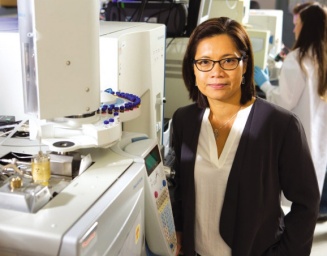Research Highlights: Prof. Diana Aga
Antibiotics in wastewater: UB chemist investigates a disturbing trend
Adapted from UBNow article written by Charlotte Hsu.

In the fight against antimicrobial resistance, wastewater is the battleground where UB chemist Prof. Diana Aga works.
Her research examines how sewage treatment systems help — or don’t help — to eliminate antimicrobial drugs and their remnants, called residues, from wastewater before it’s discharged into rivers and lakes.
This science is vital as the world seeks to better understand how bacteria and other microorganisms are becoming resistant to medicines, giving rise to “superbug” diseases that don’t respond to known pharmaceuticals.
Data on the levels of antimicrobials in wastewater and river water can help scientists understand not just the effectiveness of treatment technologies, but also how the drugs are being used in different parts of the world. This type of monitoring could provide insight into the quantity and type of antibiotics being consumed by humans and animals in a specific region, for example.
Seeking To Understand How Antimicrobial Resistance Spreads
Aga’s work looks to fill in important gaps in knowledge of how antibiotics enter the environment, and how resistance spreads. Her current and past research includes:
• Studying how the different advanced treatment processes in municipal wastewater treatment plants reduce or eliminate antibiotics and their residues from water that’s later discharged into waterways. This work is ongoing.
• Comparing levels of antibiotics and their residues in river water in Asia (Bangladesh, Hong Kong, India, the Philippines) and in the U.S. and Europe (Sweden, Switzerland). This multi-institution project includes sampling water from upstream and downstream of wastewater treatment plants in different countries. This work is ongoing.
• Investigating how well waste management systems on dairy farms reduce or eliminate antibiotics and their residues from manure. The excrement is often repurposed as fertilizer or bedding for animals, which can cause the compounds to leach into the environment. Aga’s current projects in this area are largely complete, with important results published in 2018.
In addition to researching antimicrobials, Aga has also studied how other pharmaceuticals, such as estrogens and antidepressants, may persist in wastewater after treatment. She is interested in how such chemicals may affect ecosystems, with one past study finding antidepressants or their metabolized remnants in the brains of fish in the Niagara River, which connects two of the Great Lakes.
A Need For Better Waste Management Technologies
“While traditional surveillance of antimicrobial resistance has focused on resistant bacteria from hospitals, we need to investigate the role of wastewater treatment plants and large animal facilities as potential hotspots for antimicrobial resistance,” Aga says.
Her research highlights how wastewater treatment systems worldwide have fallen behind the times. She explains that sewage treatment has traditionally focused on killing disease-causing bacteria, extracting solid matter such as human excrement, and reducing nutrients such as nitrogen and phosphorus. Anti-biotics and other pharmaceuticals, which are found in patients’ urine, have largely been ignored, along with chemicals found in personal care products such as shampoo and antibacterial soaps.
Schoellkopf Medal
When wastewater treatment plants fail to remove antibiotics from sewage, the drugs and their remnants flow into rivers and lakes, possibly contributing to the spread of antimicrobial resistance. In addition, treatment plants themselves may act as a breeding ground for drug-resistant germs, with bacteria and antibiotics mingling in sewage sludge, causing drug-resistant strains to prosper while others die out.
Prof. Diana Aga received the 2017 Jacob F. Schoellkopf Medal. The recognition, given annually by the Western New York section of the American Chemical Society (ACS), honors individuals from the Buffalo Niagara region for outstanding work and service in the fields of chemical engineering or chemistry. The medal, awarded since 1931, is the oldest award of the ACS given by a local section.
Aga is a leader in the field of environmental chemistry. She received the Schoellkopf Medal for her work on the environmental impact of emerging contaminants such as pesticides, antibiotics, pharmaceuticals, flame retardants, endocrine-disrupting chemicals and engineered nanomaterials, as well as for her mentoring efforts and service to the chemistry profession. Her research has global significance as scientists try to understand the ecological consequences of emerging contaminants and their effect on human health.